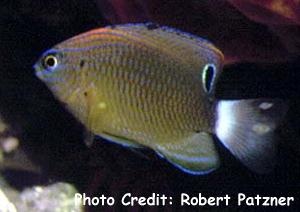
By Bob Goemans

Likely Reef Tank Suitable
Likely Fish-Only Tank Suitable
Range: Indo-West Pacific Ocean: Andaman Sea east to Marshall Islands, north to Southern Japan, and south to northern Australia.
Size: 4 inches (10 cm)
Natural Environment: Inhabits fringing reefs and outer reef faces and slopes at depths between 6 to about 130 feet (2 – 40 m) and feed mainly on filamentous algae and planktonic crustaceans.
General Husbandry: Occassionaly seen in the trade, with this hardy species having a pale lemon-yellow body, with a black spot at the base of pectoral fins. Juveniles also have an black eye spot edged in blue on the rear dorsal, which fades depending upon the area of collection, e.g., those from the Andaman Sea do not fade as it grows into adulthood.
Best maintained in aquaria having live rock with growths of various forms of algae.
As to diet, will eat most regular aquarium foods, e.g., live fortified brine shrimp and/or finely chopped various frozen or fresh meaty foods such as mysis, squid, fish flesh, shrimp, clam, etc., and plant material, e.g., flake foods, especially those containing Spirulina and offered once or twice daily.
Taxonomy:
Order: Perciformes
Suborder: Labroidei
Family: Pomacentridae
Subfamily: Pomacentrinae
Genus: Pomacentrus
FYI: Can be maintained in small groups of at least five to seven members when juveniles, however, become aggressive to peaceful tankmates as they move into adulthood.
Experience Level: Beginner
Temperament: Semi-aggressive
Diet: Omnivore
Coral Safe: Yes
Invertebrate Safe: With caution
Acclimation Time: 30 minutes+
Aquarium Environment: Reef or fish-only aquarium
Tankmates: Semi-aggressive
Minimum Tank Size: 30 gallons
Temperature Range: 74 - 84°F (23 – 28°C)
Specific Gravity: 1.020 - 1.026
pH: 8.0 - 8.5
